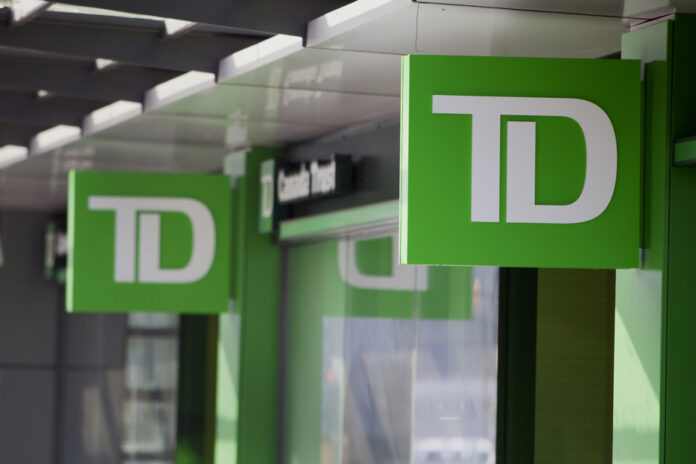(Toronto) The effects of high inflation and the central bank’s efforts to contain it by slowing the economy were felt in the second quarter results of Canada’s major banks.
Four of the big five banks posted earnings below expectations as they set aside larger sums of money for bad debts and struggled to contain rising costs. In addition, many have seen their income suffer from slower loan growth.
CIBC was the lone exception, its results, reported Thursday, coming in better than analysts had expected.
Although mortgage growth in Canada has slowed sharply, with several banks posting flat results from the previous quarter, attention these days has turned to what is happening with the U.S. operations of banks, on the heels of a few high-profile bank failures.
Several bank executives spoke of tougher economic conditions, while TD Bank warned of tougher days ahead, saying it no longer expects to meet its medium-term earnings growth target.
The recent abandonment of TD’s proposed $13.4 billion takeover of US bank First Horizon played a key role in reporting results below expectations, but the bank also cited “deteriorating macroeconomic environment”.
TD Chief Executive Bharat Masrani said in a statement that the bank was navigating an “unpredictable operating environment.” It posted a profit of 3.35 billion for the second quarter, down from 3.81 billion in the same quarter last year.
Its provisions for credit losses were $599 million, down from just $27 million a year ago.
Royal Bank chief executive Dave McKay told investors on a conference call that while the immediate financial risks of banking in the United States had subsided, there were changes ongoing issues that will have longer-term implications.
“Markets face structurally different circumstances after the end of an era of low inflation, low interest rates and increased globalization,” he said.
Cost inflation has been a challenge for Canadian banks as competition intensified last year to recruit employees, especially those with technology expertise. The trend has since reversed, but higher salaries still mean higher expenses, and sometimes more staff than needed.
The Royal, which reported spending up 16% from the previous year, did not expect high attrition rates to normalize “almost overnight,” McKay suggested.
” We exceeded. We passed thousands of people. This is a real drag on our cost structure. »
The bank attributes about half of its spending growth to acquisition-related costs and macro factors, while it plans to trim the other half through slower hiring and attrition, among other levers .
“One of my top priorities is increased cost discipline,” Mr. McKay assured.
Royal Bank posted a profit of $3.65 billion for the quarter ended April 30, up from $4.25 billion in the same quarter last year. Its provisions for credit losses amounted to 600 million, compared to a recovery of 342 million a year earlier.
On an adjusted basis, Royal said it earned $2.65 per share in the most recent quarter, down from adjusted earnings of $2.99 per share in the same quarter last year. Analysts on average had expected adjusted earnings of $2.79 per share, according to forecasts collected by financial data firm Refinitiv.
Analyst John Aiken, of Barclays, said in a note that while higher provisions might appear at first glance to be the main factor weighing on Royal’s profits, it is instead the larger cost increases. than expected, which led to this disappointing performance.
And while Royal Bank has yet to resolve its consistently high spending, it has also been challenged on the revenue side, noted Scotiabank analyst Meny Grauman, who added that for the whole of the group, the income “seemed far from extraordinary”.
Revenue was a key reason TD Bank fell short of analysts’ expectations, with adjusted earnings of $1.94 per share in its most recent quarter falling below $2.07 per share expected by analysts.
Banks faced pressure from lower interest earnings as customers shifted to higher interest term deposits and banks generally faced higher funding costs.
CIBC was able to post gains in net interest margins and hold expense growth to 1% year-over-year, or 7% adjusted, as it emerged from a major expansion program, which helped boost its profits to 1.69 billion from 1.52 billion last year.
CIBC was also one of the first to put money aside for bad debts, so its $438 million provision for credit losses didn’t rise that much from the $303 million of the second. quarter of last year.
On an adjusted basis, CIBC said it earned $1.70 per share in its most recent quarter, compared to $1.77 per share in the same quarter last year, while analysts on average had expected a adjusted earnings of $1.63 per share.
Like other banks, CIBC has sought to reassure analysts that its commercial lending exposure, particularly for U.S. office space, is under control as concerns mount over the future. any future impairments.
Its chief executive, Victor Dodig, said office loans accounted for about 2% of the bank’s overall loan portfolio and that the current situation would not last.
“We recognize the volatility. We will get through this. We will get through this. And I’m confident that values are resurfacing and investors will start to come forward to grab those properties, and people will start to come back to the office more. »
Bank of Montreal and Scotiabank also tried to provide reassurance on commercial loans on Wednesday as they posted lower profits than a year ago due to higher expenses, provisions for credit losses and losses. a slowdown in loan growth.
For the quarters ahead, banks say credit conditions are expected to return to historic norms after the pandemic years left many consumers with extra cash, which they are only beginning to run out.
Various factors such as higher interest rates, sustained inflation and other headwinds could dampen risk appetite and revenue growth, CIBC chief financial officer Hratch Panossian warned.
“We understand that the environment is normalizing. The cost of credit will increase, revenues could slow. We control the things we can control. »















